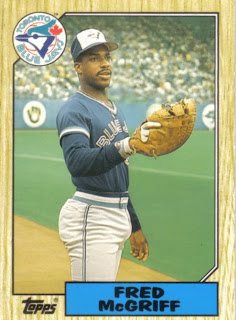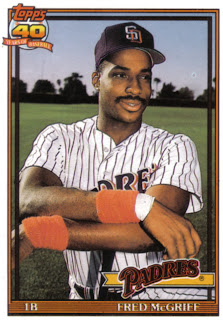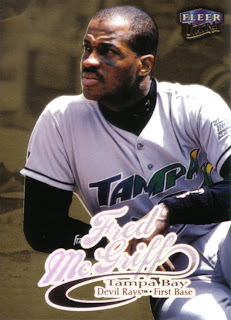 |
| McGriff 1987 Topps Traded |
It was a tough year for sluggers from the "Steroid Era" in January's Hall of Fame vote. First time nominees Rafael Palmeiro and Juan Gonzalez learned that a failed drug test or an appearance on the Mitchell Report will only result in 11% and 5% of the vote, respectively. Another first timer, Jeff Bagwell, didn't bring the same failed drug test/Mitchell report baggage, just suspicion and whispers about his body shape. Whether these whispers are fair or not, Bagwell, once thought to be a possible first ballot Hall of Famer debuted with just 42% of the vote. Admitting steroid use doesn't help you gain lost votes either as holdover Mark McGwire found out, seeing his vote percentage drop from 24% in 2010 to a new low of 20% in 2011. It appears the Baseball Writers Association of America (BBWAA) are taking the hard line with suspected and proven Performance Enhancing Drug (PED) users. So how do you explain the lack of support for Fred McGriff, one of the few sluggers from the "Steroid Era" who was not caught up in PED use allegations and never had the “PED user” label? McGriff, in his second year on the ballot, actually saw his vote percentage drop from 22% to 18%.
Controversy makes news and the Hall of Fame seems to always be more about who doesn't get in rather than who does get in. Just as Pete Rose not being on the ballot engulfed the Hall of Fame in controversy in prior decades, now the BBWAA's handling of the sluggers from the "Steroid Era" is the new controversy. A lot of BBWAA members feel like they are “gatekeepers” protecting the Hall of Fame from suspected and proven PED users. That's why it is so unfair for a player like Fred McGriff, who seemingly stayed clean and was thus overshadowed by an era of PED users, to once again be overshadowed by these same players when the BBWAA votes for the Hall of Fame. This year was bad enough but it's only going to be worst when Barry Bonds, Sammy Sosa, and Roger Clemens appear on the ballot in 2013.
McGriff, nicknamed "Crime Dog", started his major league career with five at bats for the 1986 Toronto Blue Jays, debuting the same year as Bonds, McGwire. and Palmeiro. Of the four, only Bonds played regularly in 1986. McGriff quickly established himself as one of baseball’s most feared sluggers, hitting between 31 to 37 home runs in the seven-year span from 1988 to the strike-shortened 1994 season and finished each year in the top 4 in home runs in his respective league, leading the AL in 1989 and NL in 1992. During the same seven-year span, Bonds’ combination of power and speed led the sometimes reluctant writers to overlook his strained relationship with the press and vote him the NL’s MVP in 1990, 1992, and 1993. Despite hitting home runs with the most frequency of the four, McGwire struggled to follow up his record-setting 49 home run rookie year, experiencing a drop in batting average while also suffering injuries that kept him off the field for extended periods of time during the 1993 and 1994 seasons. Palmeiro, on the other hand, was finally evolving from a doubles hitter into a home run threat.
Then things started to get silly, first baseball went on strike and then the remainder of the 1994 season along with the World Series was canceled. When play resumed, the players and their home run totals were growing at impressive and alarming rates. Bonds, McGwire, and Palmeiro all enjoyed multiple 40 home run seasons and names such as Sammy Sosa, Ken Caminiti, and Todd Hundley, along with several others, also joined the ranks of players with 40 home run campaigns. While no longer a perennial MVP candidate and home run leader, McGriff was still a very productive player, averaging 27 HR, 99 RBI, .288 BA, .371 OBP and an adjusted OPS of 122 from 1995 to 2002 before finishing his distinguished career with an injury-riddled one-year tour of duty with the Dodgers (the only season he spent time on the disabled list) and an 81 at bat last hurrah/final stab at 500 home runs the following year with the uncompetitive Devil Rays.
"Crime Dog" ended his career with 493 home runs and saw a natural decline and occasional rebound in his home run totals over the remainder of his career. By contrast, his peers Bonds, McGwire, and Palmeiro’s amount of at bats per home run decreased by almost half for the balance of their careers after the 1994 baseball strike. Bonds, McGwire, and Palmeiro rode their impressive seasons to 762, 583, and 569 career home runs, respectively. Five hundred home runs, once considered to be an almost unreachable goal, was now being surpassed almost yearly.
“Myself personally, I would laugh when I’d see these guys hit these long home runs. I mean, basically, we all came up at the same time and had about the same power.
“But before you knew it, they were hitting 50, 60 and 70 home runs. I’d just be amazed at how far they were hitting them.”-Fred McGriff in a February 2005 USA Today article written by Bob Nightengale
McGriff’s Home Run Totals vs. his peers
86-94 95-on Career total
McGriff 262 231 (95-04) 493
Bonds 259 503 (95-07) 762
McGwire 238 345 (95-01) 583
 |
| McGriff 1991 Topps Traded |
Palmeiro 155 414 (95-05) 569
McGriff’s AB per HR vs. his peers
86-94 95-on Career total
McGriff 15.2 20.7 (95-04) 17.8
Bonds 17.4 10.6 (95-07) 12.9
McGwire 14.0 8.2 (95-01) 10.6
Palmeiro 27.8 14.9 (95-05) 18.4
In the following years, many of McGriff’s contemporaries’ names and their home run totals would be called into question as one after another saw their PED use come to light. McGwire and Palmeiro would both be called before Congress in March 2005 during the investigation of steroids in baseball. “Big Mac’s” defensive and evasive testimony forever tarnished his image and the ensuing fallout may have ultimately led McGwire to finally admit in 2010 that he had indeed used steroids during his career. Palmeiro, on the other hand, went on the offensive during the congressional investigation and steadfastly denied ever using steroids only to test positive for the steroid stanozolol later that year. In addition, if we are to believe what Jose Canseco and others have said, McGwire and Palmeiro’s PED usage had its origins early in their careers and the greater part of their 500-plus home runs are suspect. Sadly, overshadowed by others’ unreal home run totals, Bonds is alleged to have joined them in PED use to bolster his already impressive home run totals. Conversely, McGriff seems to have taken the high road, which has saved him from embarrassment and dishonor only to once again be overshadowed by his peers, this time on the Hall of Fame ballot.
While it appears the Hall of Fame voters are punishing McGwire, Palmeiro, and others for their PED use during the “Steroid Era”, this hasn’t resulted in increased votes for McGriff. Many voters are quick to commend McGriff as one of the few clean sluggers during the “Steroid Era” yet write off his candidacy and say his statistics don’t quite measure up in the era he played in. Undoubtedly, “Crime Dog” did play most of his career in a “hitter’s era”, but in the five years before the 1993 expansion draft that ushered in the dawn of the “hitter’s era”, no one in baseball hit more home runs than McGriff who in addition to his power was also one of baseball’s best all around players. Though McGriff may have benefited from playing in the post-expansion hitter’s era, he also had to face his share of PED using starting pitchers, middle relievers, set up men, and closers so it’s unlikely he gained a very large number of home runs just by playing in this era.
 |
| McGriff 1997 Score |
While McGriff didn’t have the automatic Hall of Fame totals like 500 home runs or 3,000 hits, he was hardly a one-dimensional power hitter. In addition to his 493 career homers, he finished with a .284 BA, .377 OBP, 2,490 hits, 1,550 RBIs, and 134 adjusted OPS. McGriff was also a very consistent player who hit at least 19 home runs a year from 1987 to 2002, including 30 or more ten times during that stretch. While not quite Gold Glove caliber in the field, McGriff was the definition of durability, appearing in 2239 games at first base, third all time behind Hall of Famers Eddie Murray and Jake Beckley, thus preventing his team from having to use a replacement-level bench player in his place. In addition, “Crime Dog” made five All Star appearances and was the driving force that led the Braves past the Giants to the 1993 NL West Division title after his trade from the Padres just before the deadline. Unfortunately, McGriff’s impact on the Braves 1993 Division title win is largely understated since it was the third of fourteen straight for the franchise but he was still their starting first baseman and clean-up hitter two years later when they won their long overdue Championship and was one of the few Atlanta players whose post-season numbers were actually better than his regular season totals (.323 BA, .411 OBP, .992 OPS with 10 HRs and 34 RBIs in 45 games).
Foreign substances and cheating have been around throughout the history of baseball but the PEDs of the “Steroid Era” made a mockery of baseball statistics and home run totals like no other substance, whether it be “greenies”, cocaine, or a corked bat. It is unlikely that many of the suspected and proven PED users of the “Steroid Era” would have perennially hit 40 home runs or came anywhere near surpassing 500 home runs without the assistance of steroids and other PEDs. McGriff’s PED using contemporaries and their unnatural home run totals minimized his statistics and caused his achievements to be overlooked. While the BBWAA may not be admitting a proven PED user in the Hall of Fame anytime soon, it would be nice to see them take a second look at Fred McGriff’s career. Almost every player who is deemed worthy enough to be voted into the Hall of Fame has a dominant career peak and for McGriff it’s unfortunate that his career peak of 1988-1994 was overshadowed by the dawn of the “Steroid Era” and its exaggerated home run totals. “Crime Dog’s” career path seems to be one less traveled and hopefully taking the high road will one day lead to his induction in the Baseball Hall of Fame.
A quick look at McGriff’s HR totals vs. the league leaders during his career peak, his place among the leaders during the height of the “Steroid Era”, and a look at how accused and proven PED users affected HR totals
Red donates player was an accused or proven PED user or, in Albert Belle’s case, a corked bat user at some point in their career
Purple donates player was a member of the Colorado Rockies who played at Mile High Stadium or Coors Field, both extreme hitter’s parks where 30 or more home runs seemed to come easily
From 1988 to 1994 McGriff was in the top 4 in home runs for his league:
88 AL 89 AL 90 AL
1. Canseco OAK 42 1. McGriff TOR 36 1. Fielder DET 51
2. McGriff TOR 34 2. Carter CLE 35 2. McGwire OAK 39
3. McGwire OAK 32 3. McGwire OAK 33 3. Canseco OAK 37
4. Murray BAL 28 4. Jackson KCR 32 4. McGriff TOR 35
4. Gaetti MIN 28 5. Esasky BOS 30 5. Gruber TOR 31
91 NL 92 NL
1. Johnson NYM 38 1. McGriff SDP 35
2. Williams SFG 34 2. Bonds PIT 34
3. Gant ATL 32 3. Sheffield SDP 33
4. Dawson CHC 31 4. Daulton PHI 27
4. McGriff SDP 31 4. Hollins PHI 27
PED use was becoming more prevalent at the start of the 1990s but at the time 1993 and 1994 were considered “hitters years” (similar to 1987) and expansion, in addition to the emergence of smaller ballparks, had also helped bring home run totals up.
93 NL 94 NL
1. Bonds SFG 46 1. Williams SFG 43
2. Justice ATL 40 2. Bagwell HOU 39
3. Williams SFG 38 3. Bonds SFG 37
4. McGriff SDP/ATL 37 4. McGriff ATL 34
5. Gant ATL 36 5. Galarraga COL 31
From 1995 on McGriff, now in his early 30s, starts his natural decline while the league leaders and Rockies sluggers push 40 plus HRs:
95 NL 96 NL 97 NL
1. Bichette COL 40 1. Galarraga COL 47 1. Walker COL 49
2. Sosa CHC 36 2. Bonds SFG 42 2. Bagwell HOU 43
2. Walker COL 36 2. Sheffield FLA 42 3. Galarraga COL 41
4. Bonds SFG 33 4. Hundley NYM 41 4. Piazza LAD 40
5. Castilla COL 32 5. Castilla COL 40 4. Bonds SFG 40
5. Piazza LAD 32 5. Caminiti SDP 40 4. Castilla COL 40
5. Karros LAD 32 5. Sosa CHC 40
5. Burks COL 40
11.McGriff ATL 27 22.McGriff ATL 28 26. McGriff ATL 22
98 AL 99 AL 00 AL
1. Griffey SEA 56 1. Griffey SEA 48 1. Glaus ANA 47
2. Belle CHW 49 2. Palmeiro TEX 47 2. Thomas CHW 43
3. Canseco TOR 46 3. Delgado TOR 44 2. Giambi OAK 43
4. Gonzalez TEX 45 3. Ramirez CLE 44 4. Batista TOR 41
4. Ramirez CLE 45 5. Rodriguez SEA 42 4. Rodriguez SEA 41
5. Green TOR 42 4. Justice CLE/NYY 41
4. Delgado TOR 41
42.McGriff TBR 19 17.McGriff TBR 32 28.McGriff TBR 27
In the early 2000s the home run totals get even more ridiculous with most of the leaders eventually being exposed as PED users and joined by many “suspected PED users” with interesting statistical anomalies in their careers.
01 AL 01 NL 02 NL
1. Rodriguez TEX 52 1. Bonds SFG 73 1. Sosa CHC 49
2. Thome CLE 49 2. Sosa CHC 64 2. Bonds SFG 46
3. Palmeiro TEX 47 3. Gonzalez ARI 57 3. Green LAD 42
4. Ramirez CLE 41 4. Green LAD 49 3. Berkman HOU 42
4. Glaus ANA 41 4. Helton COL 49 5. Guerrero MON 39
14.McGriff TBR/CHC 31* 22.McGriff TBR/CHC 31* 14.McGriff CHC 30
*McGriff’s 31 home runs split between Tampa Bay and Chicago would have ranked him 14th in the AL and 22nd in the NL
 |
| McGriff 1999 Fleer Ultra Gold Medallion |